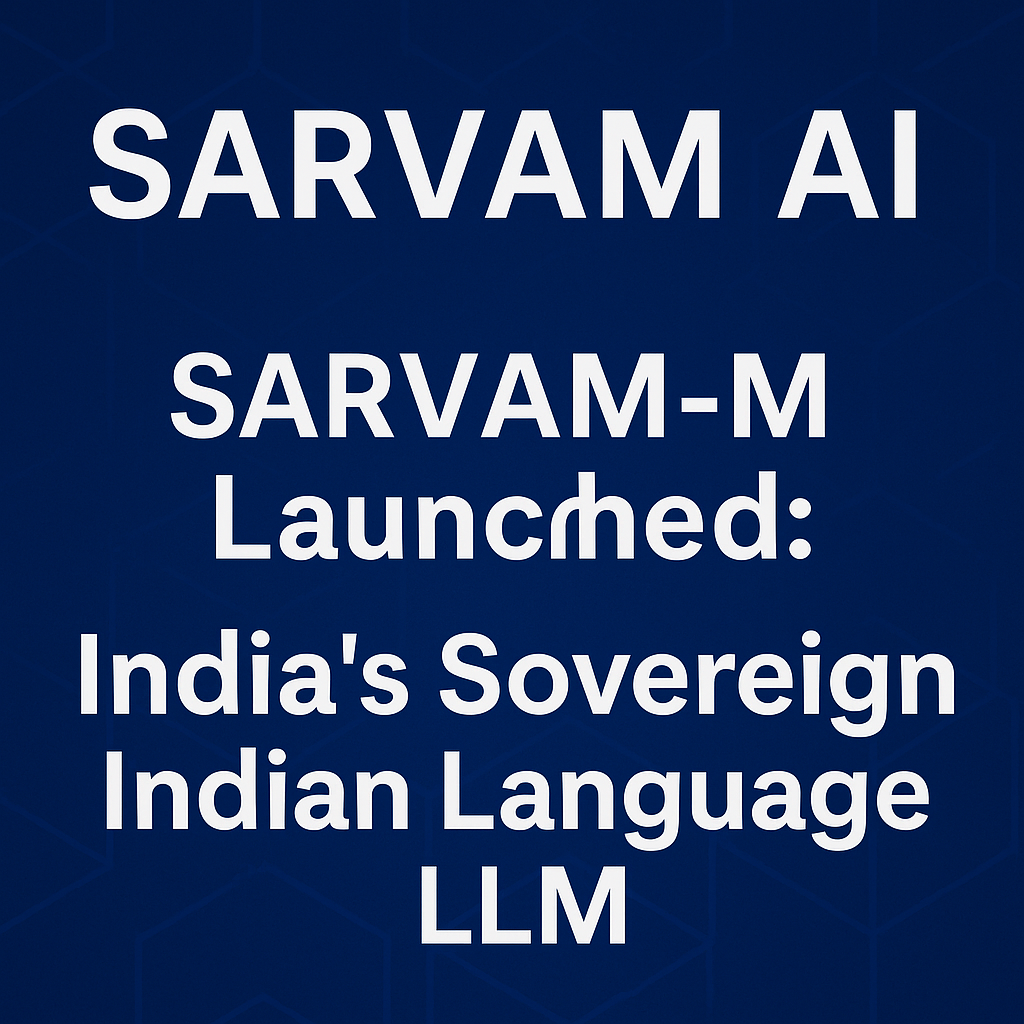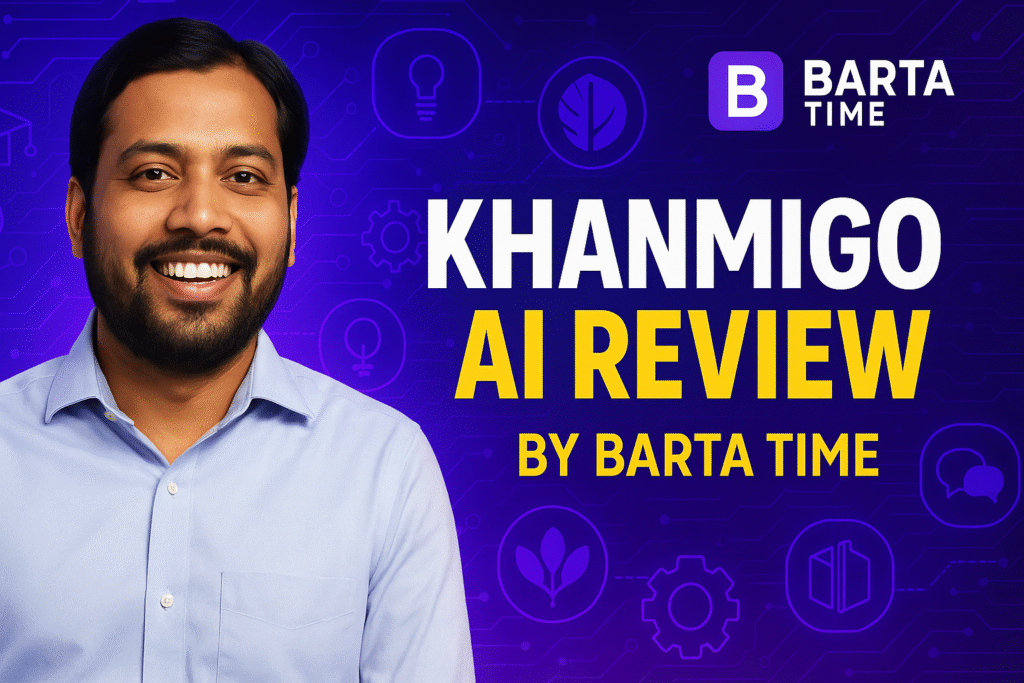
Discover how Sarvam AI’s new model, Sarvam-M, is revolutionizing India’s AI landscape with multilingual capabilities, advanced reasoning, and government-backed innovation.
Introduction
In a major stride toward self-reliance in artificial intelligence, Sarvam AI has launched its first large language model (LLM), named Sarvam-M. Developed as a part of India’s ambition to build sovereign AI infrastructure, Sarvam-M marks a critical leap forward for homegrown AI development.
With backing from the Indian government’s IndiaAI Mission, this model is not just a technological milestone—it represents India’s intent to be a global AI powerhouse.
What is Sarvam AI?
Sarvam AI is a pioneering Indian AI startup founded by industry veterans with experience at Amazon and IIT. Their mission is to build India-centric AI solutions, focusing on:
- Multilingual LLMs
- Open-source models for Indian developers
- Education and public sector applications
Sarvam AI gained recognition after being selected by the Indian government as one of the first recipients under the IndiaAI Mission, a national initiative to build indigenous foundational AI models.
What is Sarvam-M?
Sarvam-M is a 24-billion-parameter open-source LLM, built on Mistral architecture, a powerful model base developed by Mistral AI. Sarvam-M is optimized for:
- Indian languages
- Mathematical problem-solving
- Programming and logical reasoning
- Conversational and educational AI
This model is designed to compete with internationally recognized LLMs like Meta’s LLaMA-3 and Google’s Gemma 2, especially in use cases relevant to India.
Key Features of Sarvam-M
| Feature | Description |
|---|---|
| Multilingual Capability | Supports Indian languages like Hindi, Tamil, Telugu, Kannada, and more |
| Open Source | Freely available for developers, researchers, and startups |
| Advanced Reasoning | Strong performance in mathematical and logical tasks |
| Conversational AI | Can power chatbots, digital assistants, and voice applications |
| Education-Ready | Ideal for UPSC tools, NCERT content, and student support in local languages |

Why Sarvam-M is a Game-Changer for India
1. Sovereign AI Development
India has relied on Western LLMs like GPT-4, Claude, and Gemini. With Sarvam-M, India can reduce dependence on foreign tech and take control of its AI data, training, and application pipeline.
2. IndiaAI Mission Backing
Sarvam AI’s selection under the IndiaAI Mission ensures policy-level support, access to government datasets, and potential integration into public services like education, agriculture, and e-governance.
3. Empowering Indian Startups and Developers
By making Sarvam-M open-source, developers can fine-tune it for specific domains, such as law, healthcare, education, and regional journalism—something global models may not handle well for Indian contexts.
4. Enabling AI in Local Languages
From powering village-level chatbots in Hindi to educational apps in Tamil or Kannada, Sarvam-M makes AI inclusive and accessible to the masses.
Performance Benchmarks
Sarvam-M reportedly matches or outperforms global models like LLaMA-3 and Gemma 2 on key tasks involving:
- Indian language comprehension
- Code generation
- Math problem-solving
- Knowledge-based Q&A
This makes it highly suitable for applications like UPSC preparation tools, student assistants, government helplines, and translation services.
Use Cases of Sarvam-M
1. Educational Tools:
AI-powered tutors and revision assistants for NCERT, UPSC, and State Board exams.
2. Government Chatbots:
Multilingual virtual assistants for public queries, applications, and e-governance.
3. Translation Services:
Real-time translation across Indian languages for media, law, and official documents.
4. Healthcare Assistants:
AI bots to support doctors and patients in local languages with medical data.
5. Legal AI Tools:
Multilingual support for legal research, judgment summarization, and RTI queries.
Developer and Research Access
Sarvam-M is hosted on Hugging Face, and its weights are open for academic research and commercial applications under responsible AI licensing.
Developers can fine-tune Sarvam-M with their datasets or plug it into existing applications using APIs.
Visit the model on Hugging Face: huggingface.co/sarvamai
The Road Ahead
Sarvam AI is expected to release larger and more powerful models in the future, possibly scaling up to 60B+ parameters. These models will likely integrate:
- Multimodal capabilities (text, image, audio)
- Fine-tuned educational models
- Region-specific government data processing
India is also likely to see Sarvam-M powered apps in public services, smart cities, and rural development initiatives.
🧠 What is Sarvam-M and Why Does It Matter?
In recent years, the dominance of English-centric large language models (LLMs) like ChatGPT and Gemini has left a significant gap for billions of non-English speakers worldwide. India, a country with over 20 official languages and hundreds of dialects, needs AI that speaks the local tongue—literally. Enter Sarvam-M, a 24-billion-parameter open-source multilingual LLM launched by Sarvam AI, an Indian startup.
Sarvam-M isn’t just another AI model. It represents a pivotal step toward India’s AI sovereignty, designed to cater to users who communicate in Hindi, Tamil, Telugu, Kannada, Marathi, and more. Built on top of Mistral’s architecture and fine-tuned with hybrid instruction data, Sarvam-M aims to make government services, education, and digital communication more accessible for millions across the country.
⚙️ Technical Deep Dive: How Sarvam-M Works
Sarvam-M is based on Mistral Small, a powerful 7B base model, but it’s scaled and fine-tuned into a much larger 24B parameter framework. What sets Sarvam-M apart is its hybrid fine-tuning approach, involving both traditional supervised learning and RL with Verifiable Rewards (RLVR). This dual training enables the model to produce highly accurate, contextual, and factual responses across domains like education, math, and programming.
A groundbreaking feature of Sarvam-M is its code-switching ability—the model can fluently understand and respond to queries that mix English with regional languages. This reflects how millions of Indians actually speak every day, blending languages for clarity and ease. The model supports “think” and “non-think” modes for faster or more thoughtful responses and is available for developers on Hugging Face under an open license (Apache 2.0).
📊 Benchmark Performance
Sarvam-M has demonstrated impressive results across multiple benchmarks:
| Task Type | Performance Lift (%) |
|---|---|
| Math (Romanised) | +86% |
| General Programming | +17.6% |
| Indic Language Tasks | +20.3% |
| Overall Accuracy | +21.6% |
These metrics clearly show that Sarvam-M is not just a regional adaptation but a serious contender in the global LLM landscape—particularly in tasks requiring multilingual reasoning and numerical accuracy.
🤔 Controversy and Criticism
Despite the excitement, Sarvam-M has faced its share of criticism. Industry insiders have pointed out that Sarvam-M is not entirely indigenous, as it’s based on Meta’s and Mistral’s foundational models. This has sparked debates over how “Indian” the model really is. Additionally, early usage statistics were underwhelming—with just 23 downloads in the first 48 hours according to Economic Times.
Critics also question the depth of open-sourcing, noting that while inference access is available, the dataset transparency and full training pipelines haven’t been released. That said, Sarvam AI’s team, including co-founder Pratyush Kumar, has defended their approach, emphasizing performance over optics and reiterating their commitment to open innovation.
🌍 Real-World Use Cases
Sarvam-M is more than a research demo—it’s designed for practical applications in real Indian contexts:
- 🧑🏫 Education: Sarvam-M can power AI tutors that understand questions in Hinglish (Hindi + English), improving learning in government schools or online platforms like DIKSHA.
- 🏥 Healthcare: Health workers in rural clinics could use Sarvam-M-based assistants to log patient data and get recommendations in regional languages.
- 🏛️ E-Governance: Citizens can interact with chatbots to check welfare scheme eligibility, file complaints, or request documents—all in their native language.
The goal is clear: Democratize access to AI by making it multilingual, multimodal, and India-first.
🧪 Sarvam-M vs Other LLMs
| Feature | Sarvam-M (India) | LLaMA 2 (Meta) | GPT-4 (OpenAI) |
|---|---|---|---|
| Parameters | 24B | Up to 65B | Undisclosed (~1T) |
| Multilingual Support | 10+ Indic + English | 20+ global languages | 25+ global languages |
| Code-switching | Yes | No | Limited |
| Open Source | Yes (Hugging Face) | Yes (with license) | No |
| Indic Tuning Focus | High | None | Moderate |
| Ideal Use Case | Indian apps, governance | Academic NLP | General-purpose AI |
Sarvam-M clearly positions itself as India’s first LLM truly optimized for domestic needs—something even global giants haven’t fully addressed.
🙋 FAQ: Frequently Asked Questions
Q1. What is Sarvam-M?
A: Sarvam-M is a 24-billion-parameter multilingual large language model optimized for Indian languages and code-switching tasks. It was launched by Indian startup Sarvam AI.
Q2. Is Sarvam-M open-source?
A: Yes. It is available for public and developer use via Hugging Face under an Apache 2.0 license.
Q3. What languages does Sarvam-M support?
A: Sarvam-M supports English along with Indian languages like Hindi, Tamil, Telugu, Kannada, and Marathi, with more in development.
Q4. Is Sarvam-M made entirely in India?
A: No. It is based on open foundational models like Mistral Small and fine-tuned in India. This has led to some debate around its “indigenous” status.
Q5. How can I access Sarvam-M?
A: You can try it out on Sarvam AI’s Playground or download it from Hugging Face.
Final Thoughts
With the launch of Sarvam-M, Sarvam AI has planted India’s flag firmly on the global AI map. This is not just a model—it’s a movement toward AI sovereignty, language inclusion, and tech empowerment for 1.4 billion people.
For students, developers, and government agencies, Sarvam-M offers a future-ready foundation to build truly Indian AI solutions.
✍️ About the Author
This post is written by Payel, founder of Bartatime.com—a platform exploring the impact of AI, digital tools, and future tech on real lives. With a background in content creation and a passion for local innovation, Payel aims to spotlight the most impactful technology stories shaping India and beyond.

